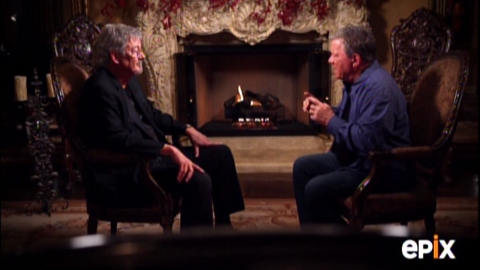 For a while now I’ve been waiting to see the William Shatner’s Get a Life! documentary. This film is part of the EPIX Originals series, and Shatner serves as one of the executive producers. He also wrote and directed this piece. After doing his documentary The Captains as part of a process of self-discovery, this was his next project, but one that is qualitatively different. Captains was a cathartic process of coming to grips with the character of Capt. Kirk by way of reflection on the other captains in the franchise. It was also, interestingly, a way of embracing the twilight of life. But William Shatner’s Get a Life! represents a process of trying to understand the intense devotion of fans to the mythology after over 45 years. Although Shatner explored some of this previously in his book Get a Life!, this documentary is the actor’s attempt at understanding the topic for himself in more depth, and for the fans whose lives he considers along the way.
For a while now I’ve been waiting to see the William Shatner’s Get a Life! documentary. This film is part of the EPIX Originals series, and Shatner serves as one of the executive producers. He also wrote and directed this piece. After doing his documentary The Captains as part of a process of self-discovery, this was his next project, but one that is qualitatively different. Captains was a cathartic process of coming to grips with the character of Capt. Kirk by way of reflection on the other captains in the franchise. It was also, interestingly, a way of embracing the twilight of life. But William Shatner’s Get a Life! represents a process of trying to understand the intense devotion of fans to the mythology after over 45 years. Although Shatner explored some of this previously in his book Get a Life!, this documentary is the actor’s attempt at understanding the topic for himself in more depth, and for the fans whose lives he considers along the way.
This film is similar to other documentary explorations of the Star Trek phenomenon, such as Trekkies, in that it devotes large segment of the documentary to portraits of various fans and showing the depth to which the Trek mythology has impacted them. This is important as the foundation for the analytical portion of the film as it attempts to answer why people like this are so enamored with the franchise, and in such deep ways. But in my view, this documentary would have been strengthened had it spent less time portraying the lives of various fans, and spent more time by way of analysis.
After laying a foundation in Trek fandom the film then begins its reflections on the meaning of this phenomenon. The analysis is interspersed periodically in the remainder of the documentary amidst the personal stories of various fans. In order to find out what Star Trek means, Shatner turns to Richard Imon who teaches Liberal Arts at Regis University. Imon uses Star Trek in his course work, and draws upon the theoretical framework of Joseph Campbell in terms of the human psyche and myth. After introducing this interpretive method Shatner then turns to Robert Walter who is President of the Joseph Campbell Foundation. For those familiar with Campbell’s work, whether through his books or the Joseph Campbell and the Power of Myth program on PBS where he was interviewed by Bill Moyers, the viewer learns little that is new. Walter explains that Star Trek functions as a powerful mythology from which people craft their own personal narratives and live this in various ways, from the hope of a united humanity, to its ethical framework, to performative and ritual aspects. This seems fairly obvious, even without the insights of Campbell’s mythological understanding, but is there more we might tease out?
In my view Shatner missed an opportunity to learn much more about the meaning of Star Trek. Not only could critical considerations related to Campbell’s view of myth been brought out, but other aspects could have been explored beyond that of the late great mythologist. Shatner could have considered some of the academic work on the ethics of Star Trek, the implications of participatory culture and performance art, convention attendance as a parallel for some fans by way of religious pilgrimage, and the various sacred aspects of science fiction and the Star Trek mythos in particular. In short, Shatner could have moved beyond the obvious in Star Trek being a significant mythology, to a consideration of whether it has become a religious phenomenon. This may seem out of bounds, but as Gary Laderman has noted, we need to expand our concepts of the sacred. Instead of formal and more traditional definitions of religion and religious institutions, Laderman suggests this is not the best way to understand the current religious landscape:
So what if the sacred is not only, or even primarily, tied to theology or religious identity labels like more, less, and not religious? We might see how religious practices and commitments emanate from unlikely sources today: science and the pursuit of truth; music and the social ecstasy of concerts; violence and the glorification of warfare; celebrity worship and technological wonders; heroic doctors and evil villains; funereal spectacles and sexual compulsions; the Super Bowl and sacrificed soldiers; Elvis and drugs, both legal and illegal.
If present experiences with the sacred have moved beyond the more traditional and familiar boundaries of the past, perhaps it wouldn’t be a stretch to add science fiction conventions, especially Star Trek conventions, as an unlikely source of the sacred in the 21st century.
This documentary will be of interest to those who want an initial exposure to reflecting on the meaning of Star Trek. But for those with more than a basic background in Trek studies, the film represents a missed opportunity to explore the mythos in more depth by drawing upon alternative interpretative possibilities. I recommend this documentary for general Star Trek fans, but for the well-read fan and the scholar, it is best to look elsewhere for fresh and deep insights on the Star Trek universe.
William Shatner’s Get a Life! is available through EPIX.







There are no responses yet